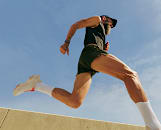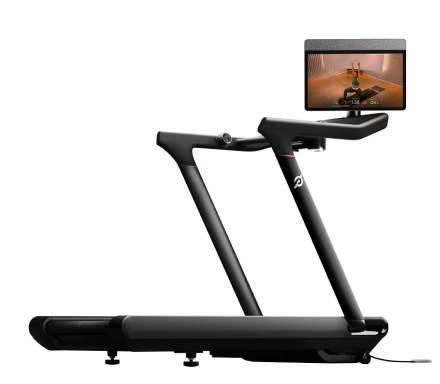
Tom Werner via Getty Images
Everything You Need to Know About Track Running
Want to build speed for a race? These workouts can be a big part of improving your running performance.
By Eric Arnold•
What Is Track Running?
The Benefits of Track Running
What Are the Limitations of Track Running?
Types of Track Workouts
How to Start Track Running
The Takeaway
If you’re a runner, you may think of track running as boring or tedious. And we get it: Going around in circles probably doesn't seem like the most exciting workout. But if you only look at the track as an oval of monotony, you’re missing out on what could be a big part of improving your running performance—no matter your experience or level.
Discover more ways to reach your goals with Peloton
Ready to give track running a try? You’re about to find out that a track is much more than a running space free of pedestrian, bike, and car traffic. There are numerous types of workouts and tips that, should you explore them, open up a world of opportunity at the track.
What Is Track Running?
Track running usually takes place on an artificial, rubberized surface. Most tracks have markings at 100, 200, and 300 meters, while running the inside lane is exactly 400 meters. That means a track is the perfect place to measure your pace and distance without having to constantly check a fitness tracking device or app. You can just run since you know exactly how far you’ve gone, how far you have to go, and whether you should pick up the pace or slow down with just a glance at your watch.
“On the Peloton Tread, yes, you do have the ability to set and forget the speed to ensure you're maintaining your pace,” says Peloton instructor Marcel Dinkins, “but that can limit your body's development of kinesthetic awareness and proper development of variable speed, which you will definitely experience [on the track].”
All that’s a fancy way of saying that track running has some distinct benefits, and you needn’t be Usain Bolt to enjoy them. Specifically, the key to boosting your performance and fitness is to dedicate at least some time to track running to ensure your body is responding accurately during the moments when you need to pick up the pace or slow down. That is, it should be your legs doing the work of propelling you forward, not your legs responding to the speed of the conveyor.

Peloton App
Access thousands of classes with no equipment needed.
The Benefits of Track Running
Any running is good running, be it a jaunt around your neighborhood, a Peloton class on a treadmill, or a visit to your local track. But the track offers a few advantages that other types of running workouts do not.
The Surface
The rubber surface of most tracks, Marcel points out, was first introduced at the 1968 Olympics in Mexico City. “It kinda acts like a springboard for runners, allowing more push-off and speed production because of the bounceback of the surface,” Marcel says. The difference between pavement and a track isn’t akin to, say, the difference between running on a dirt trail versus a soft beach—but the two are definitely not the same.
It’s a Pacemaker
Because of a track’s precise distance measurements painted on the ground beneath your feet, there’s no better place to determine your ideal running pace. “On the track it's easier to recognize when I'm running too fast or maybe that I need to speed up simply because of the repetitive nature of the lapped intervals and repetitive scenery,” Marcel says. “This always allows me to run more relaxed and stay focused on delivering at my pace.”
Pro tip: If you don't have access to a track but still want to use it for pacing, select "Just Run" or "Just Walk" when using a Peloton Tread or Peloton Tread+ and you'll be able to see a 400 meter virtual track display on your screen. The display counts your laps for you and you can see which section of the track you've completed during each lap.
It’s Great for Speed Work
If you want to boost your per-mile pace with some speed training, such as Fartlek runs or working toward improving your cadence, the track is the perfect place to do it because all the distances are marked out for you. Four laps around the track is 1,600 meters (nine meters short of a mile), so it’s easy to set your intervals, recover, then go again.
What Are the Limitations of Track Running?
There are, however, a few drawbacks to track running. The first is that it can get boring if you don’t have a workout plan that’s focused on speed or intervals. Just going in circles at one pace for a long time can get tedious. (Marcel emphasizes that a great playlist can help, however.)
Then, of course, there’s the weather. It’s hard enough to motivate yourself to run outside in excessively hot, cold, or rainy weather; it’s even harder if there’s no change of scenery. And depending on where you live, some tracks can get busy. If there are a lot of other runners of varying abilities all using the track at the same time, it can get a bit chaotic—and perhaps disrupt your training plan.
Types of Track Workouts
Marcel points out that the track is really the best place to work on your speed. “Speed training should make up about 20 percent of your overall training, unless your training plan is calling for something more specific than that,” she says. “And doing said speed work on a track as opposed to other surfaces can boost the effects.”
Building speed, however, requires focusing on certain types of workouts when you’re at the track—not just running at the same pace. Here are a few different track workouts that deliver results.
200m Building Blocks
Run halfway around the track in under 60 seconds, at least six times, with a 90-second rest between each sprint. Try this twice a week for two weeks. Then in your next few sessions, do it eight times at each session, then 10 times. This helps both sprinters and distance runners prepare their bodies to accelerate when the time is right, no matter the length of the race you’ve entered.
Fartlek Runs
These are similar to building blocks, but during the recoveries you don’t stop—you just run at your normal endurance pace. An example of a Fartlek run would be to hold your endurance pace for three laps around the track, go fast for the fourth lap, then three more at your normal pace, one fast again. Repeat that for several miles. This type of workout is great for endurance runners, especially ahead of a half or full marathon.
Straightaway Pushes
Run at your normal pace on the curves, and go faster on the straights—it’s that simple. Your first time out, do this for four laps. The next week, try it for five. Six on the next. Work your way up to 10 laps. This is great practice for a 5K or other shorter-distance endurance race in which you’ll need to balance endurance pace with bursts of power.
Mile Repeats
Run one mile (four laps) at your ideal race-day pace, then run an easy pace for a half mile (two laps). If your heart rate is back down, then run another mile—this time, try to go 10 or 15 seconds faster than you did on your previous fast lap. Then do two slow laps again. If you’re training for a half or full marathon, try and get to the point that you can do at least six race-pace miles—and the easy laps in between—without stopping.
Ladder Intervals
Run one lap at your race pace, then a slow lap. Now run two laps at race pace, followed by a slow recovery lap. Then three laps at race pace, one recovery lap, then a full mile (four laps) at race pace. This is a great way to build your speed and endurance ahead of a race of any length. As you get more confident, you can do this track workout as a pyramid: After the mile, do a recovery, then three laps at race pace, then two, then one, with recovery laps in between.
Related Articles
How to Start Track Running
The easiest way to start track running is to just get out there and do it. Marcel recommends limiting your track time to about 20 percent of your running workouts. And when you do hit the rubber, you’ll want to emphasize speed work.
“Take longer, slower distance runs out to the road or on the Peloton Tread when weather warrants,” she says. The track can help you focus because it’s easier to be mindful of your splits and “you have the nature of the surface—that's going to assist with your force production.”
What types of workouts you do and how often you take it to the track all depends on what type of race you’re gearing up for and what your goals are. So just make sure that you’re matching your speed work to your overall training plan. If you're looking for some guidance, Peloton outdoor classes offer a variety of workouts for athletes of all skill levels.
And, most of all, do track workouts that you’ll find fun. Otherwise, what’s the point?
How to Master Running On Track Curves
If you’ve ever watched a NASCAR race on TV, you’ve probably heard the announcers mention the centripetal forces of driving around an oval. You feel it when you’re running too—as you go through the turns, you’ll feel your body pulled toward the center of the track, and then released as you hit the straightaways. That’s the moment to pick up your pace. If you want to feel the effects a little less, run slower in the curves or on the outer lanes of the track (or both), but remember that in the outer lanes, you’re running longer distances. So be mindful of the markings on the ground to make sure you’re not overdoing it. You can also switch directions—clockwise versus counterclockwise, if no one else is on the track—to feel the centripetal force on the other side of your body.
How to Follow Track Running Etiquette
Especially if the track is busy with other runners, be certain to mind these track-etiquette basics.
Most everyone runs counterclockwise, so go with the flow.
When you’re running fast, be sure to use the inside lanes and move to the outer lanes when you’re running slower. If you’re passing someone, run outside them (past their right shoulder) and say, “On your right,” so they know you’re coming.
Be mindful of other runners—especially if they’re faster. Knowing where they are and that they will likely want to pass you at some point will make it easier on both of you and will hopefully prevent any clashes.
Never stop on the track. Tripping is one thing—accidents happen. But when you’re slowing to a complete stop, either move to your left (inside the oval) or all the way to your right (off the outside of the track) first.
The Takeaway
Remember, you don’t have to run on a track if you want to get faster. It’s just one extra option to keep in mind if you need a change of scenery or a tried-and-true method of building speed—and if there’s time and space in your routine for track work. But is track running essential? No. You can also do speed work on the treadmill (Peloton Tempo Run classes are a good place to start).
“[Not] all speed work should be done at a track,” Marcel says. “It just can add value to your overall training.”
This content is for informational and educational purposes only and does not constitute individualized advice. It is not intended to replace professional medical evaluation, diagnosis, or treatment. Seek the advice of your physician for questions you may have regarding your health or a medical condition. If you are having a medical emergency, call your physician or 911 immediately.
Explore Peloton Treads
Take your runs to the next level
Lace up and enter your email to get articles, instructor tips, and updates from Peloton sent to your inbox.
By providing your email address, you agree to receive marketing communications from Peloton.
For more about how we use your information, see our Privacy Policy.















